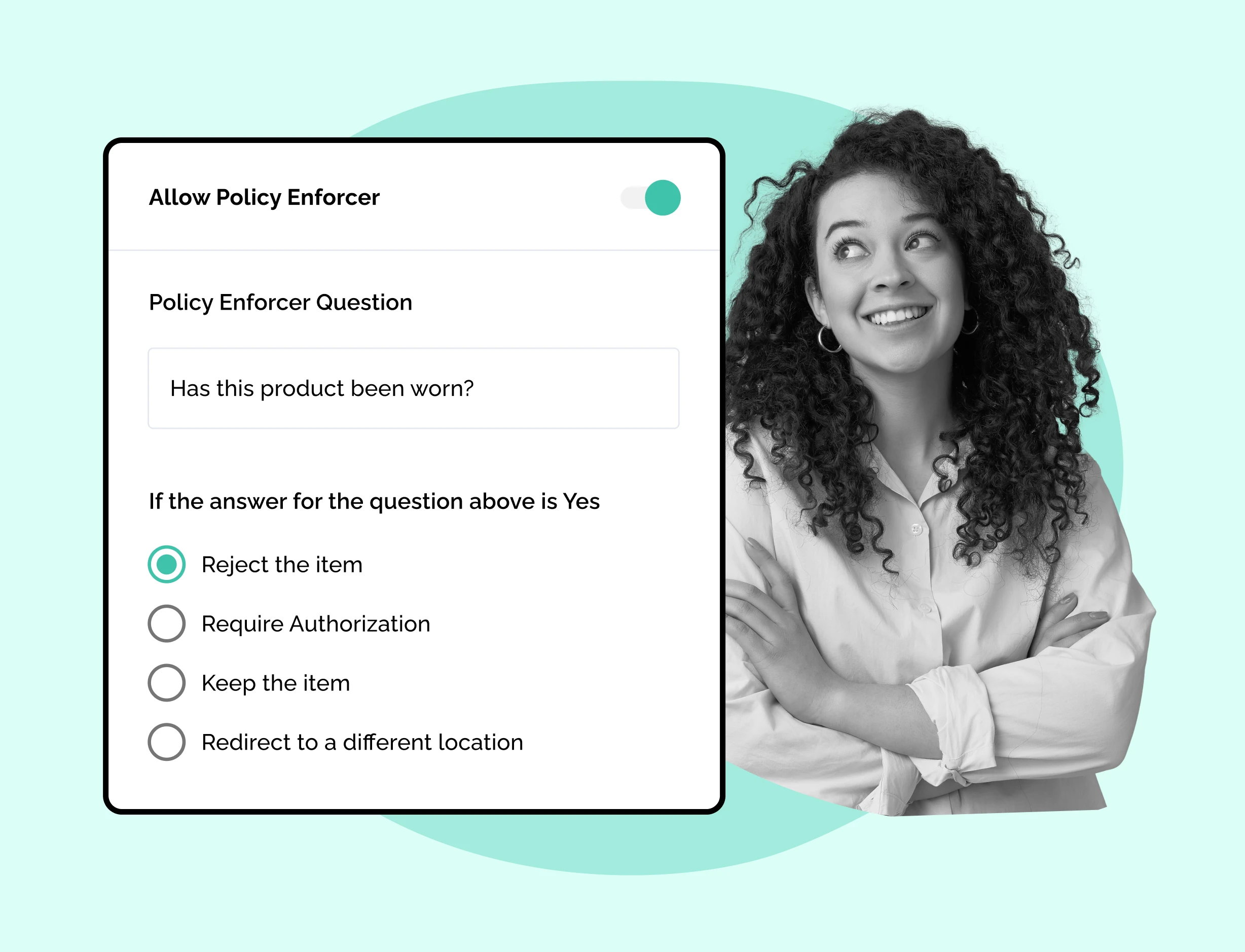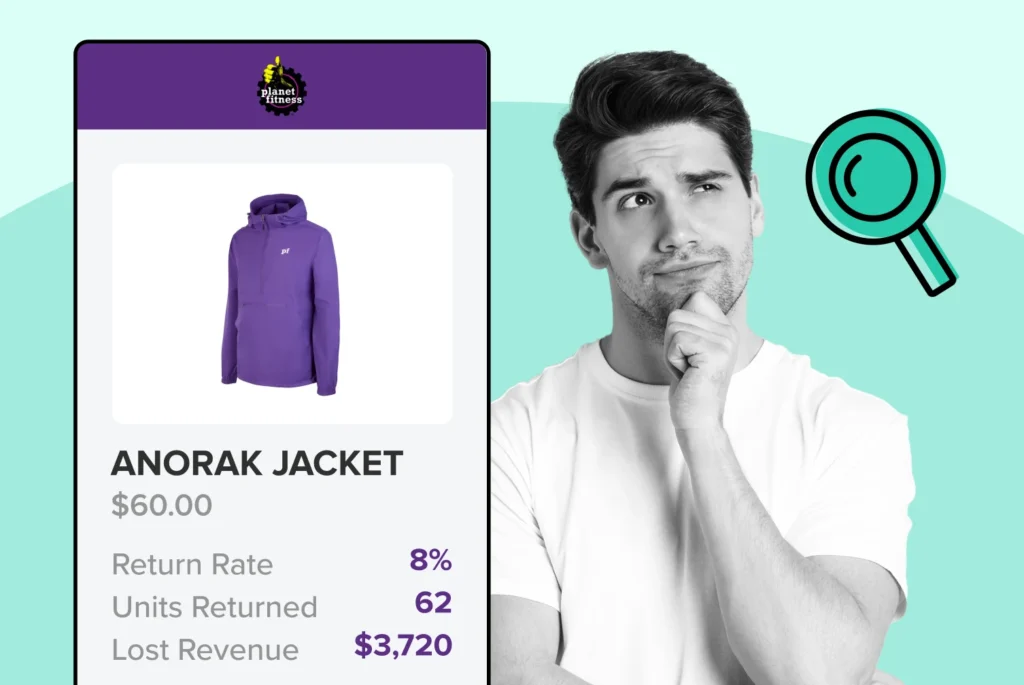
Essential Strategies for Preventing Return Fraud in Retail
Discern between fraudulent and legitimate returns & enforce preventive measures effectively: a realistic approach to preventing return fraud.
Boost customer experience and reduce support tickets
Realtime order and shipment tracking
Proactive order and shipping notifications
Predictive pre-purchase estimated delivery dates
Self-Serivce branded order tracking
Effortless experience delivered
Make returns profitable and delight customers
Flexibility to define any return destinations & conditions
Simplify returns for your customers and team
Incentivize exchanges over returns
Returns management made easy for your team
Understand why your customers are returning
Unify the online and the in-store experience
Hassle-free pickup experience for customers
In-Store Dashboard to keep operations streamlined
In-Store and Online orders unified
Drive foot-traffic to your stores
Boost customer experience and reduce support tickets
Realtime order and shipment tracking
Proactive order and shipping notifications
Predictive pre-purchase estimated delivery dates
Self-Serivce branded order tracking
Effortless experience delivered
Make returns profitable and delight customers
Flexibility to define any return destinations & conditions
Simplify returns for your customers and team
Incentivize exchanges over returns
Returns management made easy for your team
Understand why your customers are returning
Unify the online and the in-store experience
Hassle-free pickup experience for customers
In-Store Dashboard to keep operations streamlined
In-Store and Online orders unified
Drive foot-traffic to your stores
Find the answer to all your questions
Explore the most comon questions about WeSupply
Calculate the ROI that WeSupply can bring you
Request a no strings attached review of your current shopping experience and missed conversion opportunities
Take a step by step trip through our functionality to see how we can improve your ecommerce processes.
Read actionable articles on how to optimize your post-purchase experience and decrease support tickets
Get inspired by stories of how our customers implemented an effortless post-purchase experience
A Deep Dive into Top Companies' Order Tracking & Returns Strategy
Wondering if WeSupply is a good fit for you? Read through our use cases to see how we can help you increase conversion & improve CX!

Prevent return fraud to safeguard your bottom line—what specific measures can you take today? Understanding and tackling return fraud is imperative for retailers looking to maintain profitability and customer trust. This article breaks down targeted actions to help you minimize the risk of fraudulent returns and keep your revenue intact without compromising customer experience.
Return fraud costs retailers billions annually, not just in direct financial losses, but also in operational disruptions and damage to customer relationships and trust.
Retailers are combating return fraud with clear return policies, time limits, restocking fees, and enhanced proof of purchase and identification requirements to deter fraudulent activities.
Leveraging advanced technologies such as AI and machine learning is critical in detecting and preventing return fraud, and organizations must maintain a culture of integrity and educate employees to effectively manage and mitigate fraud risks.
WeSupply offers powerful tools to prevent return fraud and protect your business. With customizable return policies, advanced fraud detection, and insightful analytics, WeSupply helps minimize fraudulent returns while enhancing customer satisfaction. Features like product-specific exclusions and flexible return options such as exchanges and store credits ensure both revenue protection and customer loyalty. Ready to streamline your returns process? Get started with WeSupply today!
Return fraud is a pervasive issue that presents itself in various insidious forms, each with its own unique challenges and consequences for businesses. Retailers today face a multi-front battle against schemes designed to exploit return policies, ranging from sophisticated receipt manipulations to brazen thefts. The implications of such deceitful activities extend far beyond mere financial loss, permeating into the operational fabric and customer relations of a business.
Prying open the Pandora’s box of fraudulent returns, we delve into the nature and breadth of this menace and arm ourselves with the knowledge essential to combat return fraud and maintain the sanctity of retail transactions.
Return fraud is a chameleon, constantly changing its colors to adapt and exploit. To combat return fraud, one must first recognize its many faces. Some common types of return fraud include:
Receipt fraud, where a falsified or altered receipt is used to return stolen merchandise for full retail price
Wardrobing or free renting of apparel, where customers buy clothes, wear them once, and then return them for a full refund
Cross-retailer returns for profit, where fraudsters buy items from one retailer and return them to another retailer for a higher price
Fraudsters deploy a variety of tactics to carry out return fraud. It is important for retailers to be aware of these tactics and take steps to prevent and detect return fraud.
The retail landscape is further complicated by the advent of online shopping, which opens new avenues for refund fraud involving stolen credit cards and other sophisticated schemes. Understanding these common return fraud tactics is the first step in fortifying defenses against the potential fraud that threatens the financial health and reputation of a retail business.
The ripples of return fraud extend far beyond the immediate financial losses, which alone are estimated at a staggering $24 billion annually, representing a significant portion of retail returns. This malicious activity can escalate during peak shopping seasons, dealing a heavy blow to retailers’ profitability. However, the impact is not solely monetary; the operational burden of processing fraudulent returns, restocking devalued merchandise, and the strain on customer loyalty can impair a business’s long-term vitality.
Moreover, the tarnish on a retailer’s reputation from return fraud may deter future customers, creating a cascade of negative implications that underscore the need for comprehensive fraud prevention strategies.
Peering into the financial abyss created by return fraud reveals alarming figures; merchants in the United States grappled with losses up to $101 billion in 2023 alone. It is a bleak landscape where profitability can be undercut by 10%-20% due to fraudulent returns.
Unraveling the tangled web of costs associated with return fraud, we delve into the stark numbers that quantify the financial impact and explore the less visible yet equally disruptive operational challenges that arise when integrity in the return process is compromised.
Diving into the financial repercussions of return fraud, we encounter a harrowing reality: for every $100 in accepted returns, retailers lose an average of $10.30, a notable increase from the $8.80 lost in previous years. This loss is part of an annual hemorrhage of $7.8 billion from the U.S. retail industry, a deficit that could support thousands of jobs.
The pandemic has only intensified this issue, with a spike in return rates and fraudulent activities. As fraudsters’ methods evolve, particularly within the online retail sector, businesses must contend with sophistications that threaten to further sap their financial health.
The operational turmoil wrought by return fraud is a storm that retailers must navigate. The influx of fraudulent returns, especially during peak periods, can overwhelm employees and lead to less scrutiny of returned items, allowing fraud to slip through the cracks. The logistical complexities of processing returns are compounded by organized fraud rings that exploit lenient policies and sophisticated schemes like exploiting ‘Buy Online, Pick Up in Store’ (BOPIS) services. The monetary damages, exemplified by a reported $700,000 loss by Amazon due to a fraud ring, serve as a grim reminder of the scale of disruption that return fraud can inflict.
In grappling with these challenges, retailers must adopt proactive measures to prevent fraud and maintain operational equilibrium, as suggested by the National Retail Federation.
In the arms race against return fraud, retailers must equip themselves with an arsenal of preventive measures. Some effective strategies include:
Clear return policies that delineate conditions for refunds or store credits
Integration of technology like fraud detection software
Employment of machine learning and behavior analytics to detect anomalous return activity
These measures can significantly reduce the frequency of fraudulent returns and provide a technological bulwark against fraudsters.
By adopting these essential tactics, companies can take a strong stand against return fraud, safeguarding their financial interests and preserving consumer trust.
The foundation of an effective defense against return fraud lies in establishing clear and comprehensive return policies. These policies must be communicated in straightforward language, accessible across various customer touchpoints, and exhibit flexibility that reflects the brand’s values. By setting reasonable timeframes and detailing the expected condition for returned items, retailers can not only deter fraud but also potentially increase sales and customer satisfaction.
Transparency regarding return shipping costs and compensation strategies further reinforces the integrity of the return process and nurtures customer loyalty.
WeSupply’s Pre-built Return Policies offer a streamlined approach to crafting clear and effective return guidelines, ensuring businesses can maintain control over their return processes and enhance customer satisfaction. By implementing these policies, companies can efficiently manage returns while aligning with their strategic goals.
Key features include:
Blocklist Capabilities: Prevent fraudulent returns by blocklisting email addresses or customer groups, protecting business interests and revenue.
No Returns on Used Products: Ensure high product standards and customer satisfaction by disallowing the return of used items.
Variable Shipping Fees: Implement shipping fees based on the return reason, balancing cost management with customer service.
Another great example of WeSupply’s Pre-Built Policies tailored for minimizing fraud is the system designed to reduce return fraud among serial returners. By implementing measures that focus on identifying and categorizing customers based on their return behavior, businesses can establish tailored return conditions to deter fraudulent activities. This robust system not only protects revenue but also maintains a fair return process for genuine customers. The importance of such strategic return conditions is clear: they significantly reduce return fraud, preserve revenue, and ensure a fair return policy for all customers. Failing to address this issue can result in continued revenue loss and potential damage to the brand’s reputation.
To further dissuade fraudulent returns and price switching, retailers must consider the strategic use of time limits and restocking fees instead of offering a cash refund. These measures can prevent return abuse, such as wardrobing or returning items after prolonged use, by setting firm yet fair deadlines. Restocking fees, typically ranging from 10-25% of the purchase price, are a potent deterrent, helping to offset the costs of processing returns and maintaining a balance between discouraging fraud and retaining customer goodwill. However, the imposition of such fees should be approached with caution and transparency to avoid alienating genuine customers.
WeSupply provides effective tools to help businesses manage their return policies by applying restocking fees for specific products. This approach allows companies to mitigate the costs associated with returns while maintaining a balance between excellent customer service and sound revenue management. By setting clear guidelines on time frames and fees, WeSupply ensures that return policies are both fair and financially sustainable.
In the quest to prevent return fraud, the fortification of proof of purchase and identification requirements stands as a critical line of defense. Retailers are increasingly employing strategies like Return Merchandise Authorization (RMA) numbers to track returns and validate legitimate requests.
While not legally mandated, the verification of customer identification is a best practice for security, ensuring that the person making the return is indeed the original purchaser.
Receipts are the keystones of return transactions, yet they are prime targets for fraudulent tampering. Retailers must be vigilant for signs of receipt fraud, such as altered or expired receipts, counterfeit receipts, and excessive return patterns, which are strong indicators of fraudulent activity.
Implementing ID verification at the point of return adds an additional layer of security, safeguarding against identity theft and ensuring that the person returning the item is the true purchaser.
Verifying the identity of customers who attempt returns is a delicate balance between security and customer service. Techniques range from passive methods, like monitoring IP addresses, to active methods, such as biometric verification. Retailers must leverage technology to analyze customer data and return patterns, employing advanced tools like AI and machine learning to spot anomalies indicative of fraud.
By adopting a multi-faceted approach to identification and verification, businesses can reinforce their defenses against fraud while maintaining positive relationships with legitimate customers.
The technological revolution offers a beacon of hope in the battle against return fraud. By leveraging cutting-edge tools and software, retailers can enhance their fraud detection capabilities, dissecting large data sets to identify fraudulent behaviors and patterns.
The implementation of AI and machine learning algorithms not only streamlines the detection process but also provides businesses with the agility to respond to potential threats in real time.
Fraud detection software and tools are critical components in the modern retailer’s arsenal. Utilizing machine learning algorithms, these systems can:
Sift through customer behavior and transaction data
Flag potential fraud for further investigation
Enable real-time monitoring and analysis
Promptly detect and address suspicious activity
Minimize the risk of financial loss
WeSupply offers robust solutions to help businesses effectively reduce returns fraud through advanced fraud detection software and tools. By leveraging intelligent systems that automatically identify and block customers attempting to abuse return policies, WeSupply ensures trusted client relationships are protected. This technology is especially useful for detecting one-time use purchases or fraudulent return intents, safeguarding your business against unnecessary losses. Key features include automatic synchronization with existing block lists, customizable detection settings, and safeguards against refunds on non-returnable items, all designed to maintain the integrity of your return processes.
If your eCommerce store is running on the Magento 2 platform, you can check out the awesome WeltPixel MaxMind Fraud Prevention extension, which is designed specifically to bring MaxMind’s (one of the leading Fraud Prevention services in the eCommerce space) services over to the Magento 2 platform. The extension is officially endorsed by MaxMind and is one of the most powerful available on the market!
The meticulous analysis of customer data and return patterns is a cornerstone of proactive fraud prevention. By employing predictive analytics, retailers can leverage historical and real-time data to anticipate and intercept fraud attempts before they materialize. Anomaly detection systems play a pivotal role in monitoring for irregularities in sales transactions and customer behaviors, allowing businesses to act swiftly on atypical patterns that may signify fraudulent intent.
As fraudsters’ tactics evolve, the ability to analyze and recognize the nuances of each transaction becomes increasingly vital in safeguarding retail operations.
WeSupply empowers businesses to delve deep into customer data and return patterns with its advanced returns analytics tailored for eCommerce. By analyzing comprehensive data, companies can pinpoint the most returned products, understand the underlying reasons for these returns, and identify patterns among serial returners. This insight enables businesses to implement actionable strategies to reduce their return rates effectively. Additionally, with returns data integrated into BigQuery, WeSupply facilitates a seamless analysis process, helping businesses leverage their data for optimized decision-making and improved customer satisfaction.
Returns Analytics for eCommerce Business
Understand why your customers are returning: Identify the most returned products, Understand why those products are returned, Identify which customers are serial returners, Reduce Return Rate with Actionable Insights, Returns data available in BigQuery.
Employee training and education are the bedrock of an effective fraud prevention strategy. Staff who are knowledgeable about the various types of fraud and equipped to recognize the red flags can serve as the first line of defense against deceitful returns. A well-informed workforce is not only more vigilant but also more empowered to take the necessary actions to prevent and report fraudulent activities, maintaining the integrity of the return process.
The key components of effective fraud prevention training hinge on educating employees about the myriad forms of fraud, detection techniques, and their role in safeguarding the company. Training should aim to demystify the fraudster profile, making employees aware that anyone, regardless of appearance, can commit fraud.
By fostering a positive workplace culture and implementing secure procedures, businesses can significantly reduce the opportunities for fraud to occur. Regular surveillance and clear reporting strategies further enhance an organization’s ability to detect and respond to fraudulent behavior.
Educating employees on the direct impact of employee fraud on their compensation and job security is critical in fostering a proactive approach to identifying and reporting red flags. Training should include practical exercises, such as internal case studies, to illustrate real-life scenarios and encourage vigilance.
Furthermore, implementing technology like return management systems can aid in tracking and analyzing return trends, providing valuable insights for detecting suspicious activities.
Maintaining customer satisfaction is as much a part of fraud prevention as it is a cornerstone of good business practice. In the digital age, retailers have the advantage of utilizing platforms that meld risk management with seamless payment processing, allowing for both robust fraud prevention and a positive shopping experience.
By prioritizing clear communication and transparency in return policies, businesses can foster customer loyalty and retention while simultaneously mitigating the risks associated with return fraud.
Transparency is the lifeblood of trust in retail, and nowhere is this more critical than in the communication of return policies. Retailers must ensure that policies are clearly outlined, easily accessible, and comprehensible, avoiding legal jargon that can alienate the customer. A positive return experience not only reinforces customer trust but also influences their likelihood to repurchase and advocate for the brand.
By offering extended return windows and clearly defining the acceptable condition for returns, retailers can make customers feel at ease and reduce the likelihood of fraudulent returns.
WeSupply streamlines the communication of return policies to customers, ensuring clarity and accessibility at every step of the return process. By prominently displaying the return policy on the order lookup page, customers can easily understand and initiate returns. This clarity helps in reducing confusion and enhancing customer satisfaction.
Key features include:
Brand-Specific Return Windows: Tailor return windows for different brands or vendors, offering flexibility while maintaining control.
Post-Window Exchanges: Enhance customer retention by allowing exchanges even after the return window has expired, providing additional flexibility.
With WeSupply, clear communication and flexibility in returns are just the beginning of optimizing your e-commerce operations. Ready to see these features in action? Book a demo today and discover how WeSupply can transform your return process!
Offering store credit or exchanges in lieu of refunds can be an effective strategy in balancing fraud prevention with customer service. This approach retains revenue while providing customers with flexible options that maintain sales and relationships. It’s imperative for businesses to implement fraud prevention measures that do not impose undue burdens on customers, using streamlined processes and clear communication to avoid disrupting the customer experience.
Educating customers on the measures in place to protect their transactions can also enhance their understanding and appreciation of the business’s commitment to security.
WeSupply adeptly balances fraud prevention with stellar customer service by providing versatile options like store credits and flexible exchanges. This approach not only helps manage return rates but also enhances customer loyalty by offering choices that encourage future purchases.
Key features include:
Refund Alternatives: Offer refunds in the form of store credits, gift cards, or coupon codes, automatically enticing customers to return and shop again.
Navigating the legal landscape of return fraud requires a careful balance between protecting business interests and upholding customer rights. It’s essential for retailers to understand the legal ramifications for fraudsters and to have solid strategies in place to protect themselves against false returns. By doing so, businesses not only deter fraudulent activities but also reinforce their legal standing in the event of disputes, ensuring that they can continue to operate with integrity and within the bounds of the law.
Legal consequences for those committing return fraud can be severe, serving as a deterrent to would-be offenders. In jurisdictions like San Diego, return fraud is treated as a theft crime, with penalties ranging from fines to imprisonment depending on the value of the stolen property. Beyond the direct legal penalties, individuals convicted of return fraud may also face collateral consequences that affect their personal and professional lives, such as difficulties in securing employment and housing.
Understanding these ramifications is crucial for businesses in conveying the seriousness of fraudulent activities to employees and customers alike.
To safeguard against false returns, businesses must craft return policies that are both stringent and clearly communicated, with proper documentation to back each transaction. In cases of dispute, alternative dispute resolution methods or legal action may be necessary to resolve issues and seek damages.
Maintaining detailed records and escalating unresolved issues can bolster a business’s legal position, underscoring the importance of meticulous documentation and management oversight in the return process.
As return fraud continues to evolve, so must the strategies to combat it. In the near future, retailers will likely face an array of sophisticated fraud tactics powered by advancements in technology, such as generative AI and deep learning. By staying ahead of these developments and fostering a proactive approach to fraud prevention, businesses can protect themselves against emerging threats and ensure the continuity of their operations in an increasingly complex retail landscape.
The dynamic nature of fraud necessitates vigilance and adaptability from retailers. As fraudsters become more sophisticated, leveraging technologies like deep learning and neural networks, businesses must evolve their prevention strategies accordingly. Anticipating changes in fraud tactics, such as the rise of synthetic identity fraud and emotionally manipulative schemes, is crucial for staying one step ahead.
Retailers can employ behavioral analytics and natural language processing to monitor transactions and communications for signs of fraud, thus enhancing their predictive capabilities and securing their operations against future threats.
In response to evolving fraud tactics, retailers must be proactive in integrating the latest technologies and methodologies into their fraud prevention strategies. Blockchain technology, machine learning algorithms, and digital tracking are just a few of the tools that can be harnessed to bolster security and detect fraudulent patterns.
By maintaining up-to-date return policies and employing secure online portals for returns, businesses can streamline the return process and minimize the risk of fraud. Additionally, flagging high-value returns and monitoring customer purchase histories can provide critical insights for preventing fraudulent activities.
In the fight against return fraud, the cultivation of a culture of integrity and trust is paramount. Integrity, with its roots in honesty and strong moral principles, is the linchpin of a sustainable and successful business, fostering a reputation for trustworthiness that resonates with customers and employees alike. By consistently acting with integrity, businesses can focus their efforts on core operations, improve product and service quality, and sustain high levels of employee satisfaction.
It is within this culture of integrity that effective fraud prevention measures thrive, supported by the commitment and actions of every member of the organization.
Leadership is the cornerstone in upholding a company’s integrity and enacting effective fraud prevention measures. Leaders who embody and promote ethical principles can profoundly influence the behavior and mindset of their teams, setting the tone for an organization-wide commitment to fraud prevention. Transformational leaders, in particular, are adept at fostering a cohesive, integrity-driven culture that is resistant to fraudulent activities.
By embracing strategic thinking and adaptability, leaders can ensure their organization is prepared to address the diversity and complexity of return fraud, safeguarding their business and maintaining the trust of their customers.
In summary, return fraud is a multifaceted challenge that requires a comprehensive and adaptive approach. From defining the issue and analyzing its impacts to implementing strategic measures and leveraging technology, each aspect of fraud prevention plays a critical role in protecting a business’s bottom line. Maintaining clear communication, upholding legal standards, and anticipating future trends are all essential components of a robust fraud prevention strategy. Ultimately, fostering a culture of integrity and trust under the guidance of strong leadership is the bedrock upon which all successful fraud prevention measures are built. Armed with these insights, retailers can confidently navigate the complexities of return fraud, ensuring the resilience and longevity of their business in an ever-changing retail environment.
WeSupply offers a comprehensive suite of tools designed to help businesses prevent return fraud, safeguarding their bottom line while enhancing customer satisfaction. By employing pre-built return policies, restocking fees, advanced fraud detection, and returns analytics, WeSupply enables companies to control and streamline their return processes effectively. These strategies include specific product exclusions, blocklist capabilities, and variable shipping fees to manage costs and prevent abuse. Additionally, clear communication of return policies and flexible options like exchanges and store credit maintain customer loyalty and trust. With WeSupply, businesses can not only mitigate losses from fraudulent returns but also leverage data to optimize their strategies for reduced return rates. Ready to protect your business and improve customer returns? Get started with WeSupply today!
Speed up returns process
Book a quick call with our experts to see how WeSupply’s self-service returns makes it super easy for your customers to return anything, anytime – without needing to submit customer support tickets or call in!
Wardrobing is a form of return fraud where customers purchase items, use them, and then return them for a full refund, contributing to the broader issue of return fraud by exploiting return policies.
Businesses can quantify the financial impact of return fraud by calculating the average loss for every $100 in accepted returns and considering the total annual losses to the industry, which amounted to $7.8 billion in 2020. These figures emphasize the substantial financial burden imposed by return fraud on retailers.
Retailers can combat return fraud by establishing clear return policies, implementing time limits for returns, charging restocking fees, and strengthening proof of purchase and identification requirements. Leveraging technology like fraud detection software and employee training programs are also effective measures.
WeSupply provides a comprehensive suite of tools, including customizable return policies, advanced fraud detection, and insightful analytics, to help businesses identify and mitigate fraudulent returns effectively.
Key features include specific product exclusions, blocklist capabilities, and variable shipping fees to manage costs and prevent abuse. Additionally, WeSupply offers flexible return options such as exchanges and store credits to enhance customer satisfaction while safeguarding revenue.
Yes, WeSupply provides returns analytics tailored for eCommerce, allowing businesses to analyze comprehensive data and identify trends among customers and products. This insight enables companies to implement actionable strategies to reduce return rates effectively.
Yes. WeSupply has an Official Shopify App. You can download it and start integrating with your Shopify Store.
Yes, WeSupply has an official extension for Magento. The WeSupply x Magento integration allows for automating order tracking experiences, reducing customer inquiries, automating shipping email and SMS notifications, and providing a fully branded order tracking experience
Yes, WeSupply has an official BigCommerce App. You can integrate WeSupply with your BigCommerce store to improve your post-purchase customer experience.

Learn How To Create Successful Post Purchase Email Campaigns
Build an effective post-purchase email flow that helps you increase customer satisfaction and drive revenue growth!

Discern between fraudulent and legitimate returns & enforce preventive measures effectively: a realistic approach to preventing return fraud.

Explore crucial data that will directly inform your strategy and operations: return rate, average return value, and customer refund patterns!

Let’s dive into innovative approaches that equip you with actionable insights on harnessing the full potential of returns data!

How you can leverage the different return metrics to fine-tune your business strategy and drive sustainable growth!

Concrete strategies for preventing ecommerce return fraud: from strengthening your return policy to leveraging technology and analytics!

Practical strategies and real-world applications to turn your returns into a powerful operational efficiency and customer satisfaction tool!

Let’s explore the tangible impact of retail analytics, revealing how it informs strategies, optimizes operations, and predicts market trends!

Discover how to tackle this complex aspect of online selling and let returns add value to your Shopify store rather than subtract from it!

Minimize returns and cultivate customer loyalty! Let’s explore how a return analytics dashboard can be critical to your business’s success!